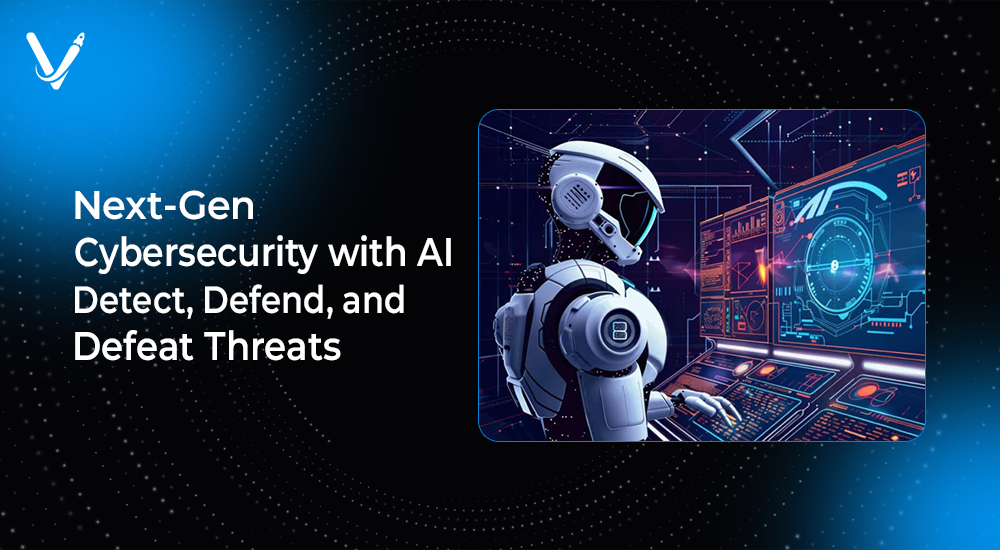Next-Gen Cybersecurity with AI: Detect, Defend, and Defeat Threats


- Oct 14, 2025



Key Takeaways
In today’s hyperconnected world, digital security is no longer an optional investment—it’s a necessity for survival. Every organization, regardless of size or industry, faces an expanding battlefield filled with ransomware, phishing, deepfakes, and advanced persistent threats that evolve faster than traditional defense systems can adapt.
Cybercriminals are now leveraging automation and AI themselves, creating attacks that are faster, smarter, and more deceptive than ever before.
AI in cybersecurity represents the next phase of defense evolution. It enables systems to think, learn, and act like human analysts but at machine speed and global scale. By combining automation with predictive analytics, AI doesn’t just detect breaches—it anticipates and neutralizes them before they cause damage.
This article explores how AI is revolutionizing cybersecurity, the technologies driving this transformation, the benefits and challenges it brings, and how businesses can harness AI to create intelligent, self-learning security ecosystems.
Cyber threats have evolved from simple malware into multi-stage attacks that exploit human behavior, network vulnerabilities, and AI-generated deception. Traditional security systems—reliant on static rules and reactive responses—can no longer keep up.
Modern attackers use automation to scan thousands of systems simultaneously, employ machine learning to craft personalized phishing campaigns, and even deploy deepfake videos to manipulate corporate decisions.
The result? Security teams face an impossible volume of alerts, data, and false positives, often leading to fatigue and delayed responses. According to IBM’s Cost of a Data Breach Report, the average breach takes over 200 days to identify and contain—a timeline cybercriminals exploit to maximize impact.
The only way forward is through intelligent automation—systems that can learn, adapt, and respond in real time. This is where AI transforms cybersecurity from a defensive shield into a proactive guardian.
Artificial Intelligence in cybersecurity is not a single tool—it’s an ecosystem of intelligent algorithms that empower systems to detect, analyze, and respond autonomously.
AI enhances every stage of the cybersecurity lifecycle:
By applying machine learning and deep learning, AI systems sift through terabytes of security logs, network traffic, and behavioral data to identify patterns invisible to humans.
In essence, AI doesn’t just analyze—it understands context, enabling organizations to detect anomalies faster and react before attackers strike.
Detection is the most critical and time-sensitive aspect of cybersecurity. Traditional tools rely on known signatures or rule-based detection, but AI goes beyond. It identifies unknown and evolving threats through continuous learning and behavior analysis.
AI systems establish a “normal” profile for users, devices, and networks. Any deviation—such as an employee logging in at an unusual time or a sudden spike in data transfer—triggers alerts. This approach enables zero-day attack detection, where even unseen threats are flagged based on unusual activity.
Machine learning algorithms learn from previous incidents, improving their ability to detect subtle anomalies that humans might overlook. These models continuously refine themselves, reducing false positives and increasing precision over time.
NLP helps cybersecurity systems analyze textual data such as phishing emails, chat logs, or malicious code. It detects suspicious language patterns, emotional tone, or unusual phrasing that might indicate social engineering attempts.
AI combines multiple data sources—network logs, global threat feeds, and endpoint telemetry—to identify new attack signatures. This global intelligence network enables predictive threat detection at a global scale.
By leveraging these mechanisms, AI-powered systems achieve faster detection rates, reduced false alerts, and higher accuracy, making them indispensable in modern security architectures.
Detection is only half the battle—AI excels at defending digital ecosystems through automation and real-time response.
Once a threat is identified, AI-driven systems can isolate compromised devices, block malicious IP addresses, or restrict user access instantly—without waiting for human intervention. This automation drastically reduces response time from hours to milliseconds.
Traditional firewalls rely on predefined rules. AI-enabled firewalls dynamically adjust these rules based on network behavior and traffic anomalies, providing continuous defense against evolving threats.
AI-powered endpoint detection and response (EDR) tools monitor devices continuously, identifying unauthorized activity or unusual application behavior. They neutralize threats locally before they spread across networks.
AI analyzes communication metadata, tone, and sender authenticity to detect phishing or spear-phishing attempts. It can also simulate attacks internally to train employees—a proactive defense strategy.
AI orchestrates multiple defense tools into a unified response system. This ensures coordination across cloud, on-premises, and hybrid environments—essential for large-scale enterprise protection.
AI doesn’t just defend reactively—it learns from every incident, making future defenses smarter and more resilient.
The most powerful capability of AI in cybersecurity lies in defeating threats before they occur. By leveraging predictive intelligence, AI transforms cybersecurity from a reactive function to a preventive one.
Using historical data and global attack trends, AI predicts potential attack surfaces, allowing teams to reinforce vulnerable systems before attackers target them.
AI models detect subtle, early-stage signs of a breach—such as changes in file access frequency or user session timing—and alert security teams for immediate action.
AI simulates attacks to identify vulnerabilities proactively. This self-assessment helps organizations stay ahead of hackers by finding weak spots before they are exploited.
AI continuously scans systems, logs, and user behavior to identify hidden risks. It enables proactive hunting for latent threats that may evade signature-based systems.
As AI encounters new data, it evolves. The longer it operates, the smarter it becomes—anticipating sophisticated attack methods before they become mainstream.
In this way, AI shifts the paradigm: cybersecurity becomes predictive and preventive, not just reactive.
The strength of AI-driven cybersecurity lies in its technological diversity. Each component plays a specific role in detecting, defending, and defeating cyber threats.
ML algorithms analyze historical security data to identify emerging threats. They continuously retrain on new information, improving detection accuracy and reducing human intervention.
Using neural networks, deep learning mimics human brain functions to detect complex attack signatures like polymorphic malware or zero-day exploits. It processes vast, unstructured data such as images, audio, or code patterns.
NLP detects linguistic anomalies in communications or code. It identifies fraudulent emails, social engineering attempts, and even fake news used in disinformation attacks.
AI systems using computer vision can monitor visual data, such as CCTV or biometric authentication systems, detecting anomalies in physical security environments.
AI thrives on data. Integrating cybersecurity with big data analytics enables organizations to correlate logs, network traffic, and behavioral signals across millions of endpoints in real time.
These advanced models map relationships between users, devices, and applications to uncover hidden attack paths—ideal for insider threat detection.
Together, these technologies empower a multi-layered, self-evolving defense architecture that adapts to every new cyber challenge.
AI’s impact extends beyond theory—it’s already redefining real-world cybersecurity practices.
Financial institutions use AI to analyze transaction patterns, identifying suspicious behavior such as unauthorized transfers or identity theft. Adaptive models distinguish between genuine and fraudulent activity with remarkable precision.
AI monitors cloud workloads and user access in real time. It ensures compliance, prevents data leaks, and protects cloud infrastructure from insider misuse.
AI safeguards sensitive patient records through anomaly detection, ensuring HIPAA compliance and preventing medical data breaches.
Power grids, manufacturing plants, and transportation systems use AI for continuous monitoring of control systems, protecting against state-sponsored cyberattacks.
AI algorithms detect bots, fake accounts, and misinformation campaigns, maintaining the integrity of digital platforms.
These applications illustrate AI’s broad utility—a universal security framework across industries that adapts to context and complexity.
The integration of AI into cybersecurity ecosystems provides tangible business and operational advantages:
These benefits position AI not as a replacement for human cybersecurity experts, but as an intelligent co-pilot—augmenting human judgment with computational precision.
Despite its advantages, AI adoption in cybersecurity comes with challenges that organizations must address strategically.
AI models depend on quality data. Inconsistent or biased datasets can result in false predictions and ineffective defenses.xc
Cybercriminals are also using AI to craft attacks capable of deceiving detection algorithms—known as adversarial attacks. Defending against AI-powered hackers requires continuous innovation.
Developing and training AI models demands significant computational resources and specialized talent, increasing upfront costs.
AI-cybersecurity integration requires professionals skilled in both domains. The shortage of hybrid talent slows implementation for many organizations.
Excessive data collection for AI training raises concerns around privacy and compliance. Transparent data governance is crucial for maintaining trust.
Overcoming these challenges requires a strategic roadmap that balances innovation, cost, and compliance.
The future of cybersecurity will be autonomous, predictive, and adaptive—driven by continuous learning and AI collaboration.
Emerging trends include:
In essence, the future of cybersecurity isn’t just smarter—it’s self-aware, self-defending, and self-improving.
For enterprises, integrating AI in cybersecurity isn’t a futuristic option—it’s a present-day business necessity.
Cyberattacks are no longer isolated events; they’re organized, persistent operations targeting brand reputation, data assets, and customer trust. Delayed adoption of AI-driven protection exposes organizations to massive financial and reputational risks.
Businesses that invest early gain a decisive competitive edge—protecting data, ensuring compliance, and building customer confidence. Moreover, AI-enhanced security drives digital transformation safely, enabling innovation without fear.
Founders, CIOs, and investors who prioritize AI-based defense strategies today will lead tomorrow’s secure digital enterprises.
Artificial Intelligence has become the heartbeat of modern cybersecurity. By blending machine intelligence with human expertise, organizations can detect, defend, and defeat threats at unprecedented speed and accuracy.
As cyberattacks grow more sophisticated, static defenses are no longer sufficient. The future belongs to systems that learn continuously, adapt instantly, and predict accurately—qualities that define AI-driven security architectures.
At Vasundhara Infotech, we help enterprises harness the full power of AI in cybersecurity—designing intelligent systems that monitor, analyze, and protect digital assets across all environments. Our solutions combine automation, predictive analytics, and human insight to create a resilient security posture that evolves with the threat landscape.
Secure your digital future with intelligence.
Partner with us today to build AI-powered defense systems that detect, defend, and defeat threats—before they even begin.
Why choose Vasundhara Infotech for AI cybersecurity solutions?
Our AI-driven cybersecurity frameworks combine advanced analytics, automation, and domain expertise to deliver intelligent protection for businesses of all sizes.
Copyright © 2025 Vasundhara Infotech. All Rights Reserved.